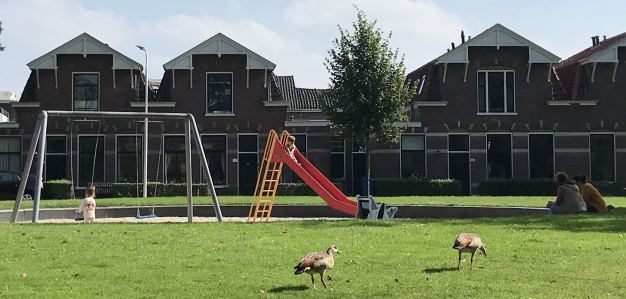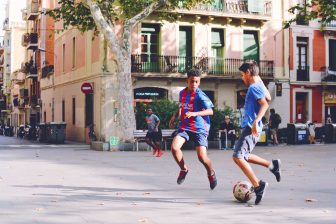
Playing outside: who, where and what?
Fortunately, more and more attention is being paid to a play-friendly public space in both research and policy. Yet there is still little insight into very basic questions. For example, do boys play more outside than girls? Where do children play? And what are they doing there? New research answers these questions
In September and October 2021, thirty students from The Hague University of Applied Sciences conducted research in the Netherlands. Every student walked crosswise through their own residential area on at least two different days to observe where and which children are playing outside, writes urban geographer Gerben Helleman, author of the blog Urban Springtime.
In addition, we looked at who they play with and what activities they undertook. These observations were made on random weekdays after school (92 per cent) and sometimes on weekends (eight per cent). A total of 1,191 children were observed in twenty different municipalities (see figure 1).
 |
| Figure 1. Locations in the Netherlands where playing children have been observed |
Who’s playing outside?
The fact that children play outside is no longer as self-evident as it was in the past. Due to various social and urban developments, the playtime that children spend outside has decreased considerably (Dellas et al., 2018; Kantar Public, 2018; Meire, 2020). But who still plays outside?
Gender
In the 1960s and 1970s, more boys played outside than girls. In those days girls were constrained by domestic tasks and being entrusted with the younger family members at home. While the boys could climb trees, get muddy in the pond and return home with their clothes torn, the girls were expected to return immaculate. Boys were left much more free, which meant that they went outside more often (Ward, 1978). The question is whether these differences have persisted? In Flanders (Belgium), this is well documented with a study that was conducted in 1983, 2008 and 2019 in seven residential areas in and around the city of Antwerp (Meire, 2020). This research showed that boys play much more outside than girls between the ages of three and fourteen. In 2008, girls were already slightly underrepresented at 45 per cent, but in 2019 this had already fallen to 37 per cent. A percentage equal to the 1983 results.
In the Netherlands little data is available about who plays outside. And if there is data at all, this is often based on research in which parents were asked about the outdoor play behavior of their child(ren). For example, based on such a survey, the Mulier Institute concluded that 63 percent of boys – aged four to eleven – play outside five to seven times a week, compared to 58 percent of girls (Dellas et al., 2018).
Our research is not about estimates by parents, we have looked at the actual behaviour of children. We defined outdoor play as playing in public space. Playing in private environments, such as in a front or backyard, has not been taken into account. Children who were traveling on foot or by bicycle were also not included in the study.
We also encountered significantly more boys than girls. Two-thirds of the children playing were boys (66 per cent) and only one-third (33 per cent) were girls.
Age
We encountered very few young children (0-4 years old) during our measurements (10 per cent). This is not very surprising, because this age group depends still very much on a parent who takes his or her kid to for example a outdoor playground. When this age group plays outside independently, this is mainly in the vicinity of their own house.
We mainly encountered children between the ages of five and eight (34 per cent) and between the ages of nine and twelve (39 per cent). The ages at which, in general, children play outside more often. These are also the age categories in which a child is given more and more freedom by the parents to play at a greater distance from their own home. This increases their range and options.
Children who leave primary school (from about the age of twelve in the Netherlands) generally play less outside. There are various reasons for this, such as new interests that relate to their new stage of life, less leisure time as a result of increasing homework, the possibilities indoors (internet, social media, TV), and a public space that is less suited to the play needs of older children. In only 17 per cent of the observations we encountered a child of thirteen years or older.
Gender and Age
If we combine these findings and look at both gender and age, an interesting picture emerges (Figure 2). In the younger age group – from zero to eight years – the ratio between boys and girls is almost equal. However, large differences arise with age. Girls aged nine or older are playing less in public space than their male peers.
If we look at the absolute numbers, we encountered the most girls in the age category of five to eight years and most boys between the ages of nine and twelve.
 |
| Figure 2. Who plays outside according to gender and age (in percentages and numbers)? |
Who is playing with who?
Playing outside has several advantages. In addition to the positive influence on health and motor skills, children also develop their social skills while playing outside. By playing with other children (or adults), they learn to cooperate, discuss and compromise. And in a playful way they learn more about the applicable norms and values, and new friendships are formed. As Dave Ebsberg-Kleijkers, director of Jantje Beton – a charity that stimulate outdoor play -, aptly puts it: “Practicing being with others starts with playing together. Playing together later becomes working together and living together.”
Alone or together?
In other words, you don’t play outside alone. This is also apparent from our research. In only eight per cent of all observations, a child was playing alone. Most children were playing with other children (82 per cent). Only four per cent were playing with adults and 6% were playing with one or more children and adults.
Supervision
One of the characteristics of outdoor play is that it often has an open, unpredictable and unstructured character. It concerns unsupervised play that is initiated by children themselves. The kids – not the adults – are in the lead. The statistics above also show this: adults hardly ever participate. But are they not there at all? Yes they are, and actually more than we expected. In no less than 47 per cent of the observations, there were also adults. Often not to play together with their kids, but to supervise – at an appropriate distance. Logically, more adults were present among the younger children than among the older children (see figure 3).
 |
|
|
Yet it is striking that even in 25% of the cases an adult was present with the children between the ages of nine and twelve. On the one hand, this may be due to the observation of playspaces where children of various ages were present and that the parent concerned was only supervising one of the younger children. On the other hand, these outcomes also fits the theory that parents increasingly want to protect their child against traffic and the angry outside world (‘stranger danger’). Some parents have developed an excessive need for control and safety (Gaster, 1991; Torrance, 1998; Karsten, 2005; Gill, 2007; Fyhri et al., 2011; Woolley & Griffin, 2014). This protection thinking is generally at the expense of children’s independent freedom of play and movement. For example, in a survey in twelve countries, 51 per cent of parents said they were too concerned about their child’s safety to allow them to play outside (Ingka Group, 2015).
In addition, the girls are more ‘supervised’ than the boys. An adult is present in 62 per cent of the observed girls, while this is only 38 per cent for boys. This difference is especially noticeable during primary school age (4-12 years). In the age range between zero and four years and above thirteen years, the difference between boys and girls is much smaller.
Where do children play?
When playing outside, children look – within their possibilities and wishes at that moment – for a place where they can have the most fun. They can use different types of play areas for this. You can roughly divide these into two categories:
- Formal playspaces, such as a playground, schoolyard or sports field. These are often closed and fenced areas that are specifically designed for certain target groups (‘places for children’) and that often also function as meeting places.
- Informal playspaces, such as the sidewalk, shrubs, bushes, lawns and residual spaces. These spaces are not designed as such, but are made their own by the children (‘children’s places’). For example, by playing on the curb, by chalking on the sidewalk or by playing in the bushes.
In our study, we encountered most children in formal play areas (Figure 4). About two-thirds of all children were playing here with a large over-representation of playing in playgrounds. About a third played in areas that were not set up as such, especially on lawns and on the street. With other words: playing outside is more than just using fixed play attributes in standardized playgrounds.
 |
|
|
Again, there is a clear gender difference. Of all the girls we observed, we encountered no less than half (51 per cent) in a playground and after that in a schoolyard (14 per cent). We saw the boys in more diverse places, such as the playground (29 per cent), the sports field (22 per cent), the schoolyard (13 per cent) and on a lawn (11 per cent).
Looking at the locations, we see on average a nice equal distribution between boys and girls in the playgrounds (52-48 per cent) and in the bushes and shrubs (50-50 per cent), while the sports fields (92 per cent) and lawns (82 per cent) are dominated by boys.
Figure 5 shows that babies and toddlers (0-4 years) mainly play in the playground (62 per cent) and on the street, sidewalk or neighbourhood square (17 per cent). This is also the case for the five to eight age group, but they also go to the schoolyard outside school hours (15 per cent). A play area that they can find better, because they go to school now and where they may be allowed to go independently. The playground is less popular with older children and, in addition to the lawn, the sports field is becoming increasingly popular (from 0 to 38 per cent). This is not the case with the (primary) schoolyard, which is used less at an older age. Which makes sense given the transition to secondary education.
 |
|
|
What do the children do while playing outside?
 |
| Figure 6. Children’s outdoor play activities (in percentages) |
Interestingly, a significant proportion of the children (12 per cent) were also doing ‘nothing’. So instead of actively playing, they were relaxing, hanging out, sitting, watching or talking to other children. This is also known as ‘receptive play’. With 15 per cent, this was even the second most important activity for the girls.
About ten percent of the children were running, especially between the ages of five and eight. This as a result of playing tag or hide-and-seek, but also running from one playground equipment to another. Or in the context of a ball game, such as stoop ball, dodgeball or keep away.
Seven per cent of the children were skateboarding, roller skating or rollerblading. Bundled here under the umbrella term ‘wheel sports’.
Summary
Based on this research, it can be concluded that boys still play outside more than girls, especially at a later age. In playgrounds we see a balanced distribution by gender, while the sports fields and grass fields are dominated by boys. The formal playspaces – such as schoolyards, sports fields and playgrounds – are used more than, for example, the sidewalk, street or bushes.
However we cannot draw the conclusion that children have a stronger preference for these kinds of formal play areas. After all, where children play is highly dependent on the possibilities we give them through the design of the built environment (Helleman, 2018). Anyone who lives in a busy street with many (parked) cars and a narrow sidewalk is forced to go to a playground or football field. However, this design of public space seems to create inequalities. Older children and girls in particular seem to give up searching for interesting places and therefore play less outside. Follow-up research is needed to see how the built environment positively or negatively influences the extent of outdoor play.
Gerben Helleman is an urban geographer based in The Netherlands, and the author of the blog Urban Springtime. This article is republished with his kind permission. All photos and figures by Gerben Helleman.
This article is also available in Dutch










